New York Times' 'metered' access follows Pandora, Financial Times
Loading...
How much is the news worth? Does paying for access to a website make sense? How much is too much? Will readers flee?
These are questions many were chewing on Wednesday, as word from The Grey Lady arrived, confirming speculation, that in 2011 it would implement a "metered" access system for its award-winning website.
A print subscription will get readers unlimited access to nytimes.com. Beyond that, specifics were sparse, both in the official press release and a memo to staffers from Times President and CEO Janet L Robinson and Publisher Arthur Sulzberger, Jr. But the scheme is clear: if you visit nytimes.com multiple times a month, expect to be cut off unless you fork over some cash.
How many and how much?
The Times' new model is similar to ones already in place at a few websites. Internet radio site Pandora.com implemented a system last July that limited users to 40 hours a month of ad-supported free music. Pay $36 a year and the ads – both audio and displayed – disappear, along with the 40-hour limit. And membership applies across all devices – including a standalone player and the Android and iPhone apps. [Editor's note: A Pandora rep reminds that once their 40 hours run out, listeners can purchase unlimited music for the rest of that month for just a dollar, but the ads stick around.]
London's Financial Times, a little closer to the Times than Pandora, has for years operated with metered access. Currently, visitors to the pink-hued FT.com can read 10 free articles a month. For unlimited access, rates vary from $3.59 a week for Web-only, to $7.55 a week for the print paper, full website access, and a host of online financial research tools.
Expect the [New York] Times to allow for more free access than its pink peer. The nature of the site's content – everything from national political news to offbeat "must-email" pieces – means that even casual visitors used to doing a lot of clicking around would exhaust their free allotment fairly quickly were it capped around 10 free articles per month. As for what a digital Times subscription will cost, the company has only said that the metering will "provide the necessary flexibility to keep an appropriate ratio between free and paid content and stay connected to a search-driven Web."
"Free" survives – for now
The Times' move to metering preserves the search-based Web model. Times content will still find its way into search results and onto aggregators like Google News. What will be interesting to see is whether the new pay model will move more to make use of services like Google's Fast Flip. The news-reading tool was developed to give visitors more of a print-like experience online, allowing them to "flip" through stories quickly and easily, without having to load new pages of websites. The Times was one of its 36 charter publications and (full disclosure) so was the Monitor.
Every indication is that the Times will continue to share content with it and other aggregation systems, but it's not hard to imagine a situation where a Times reader, trying to avoid paying a monthly fee, stops using the main site and just gets Times content through Fast Flip or another service. (And that's to say nothing of users who could just create multiple logins to cycle through each month to avoid paying fees).
––
What's your take on the Times' plan to charge for access? Many have already weighed in, but how much would you pay for access to an online newspaper like the Times (or the Monitor)? And for the latest in tech, be sure to follow us on Twitter.





